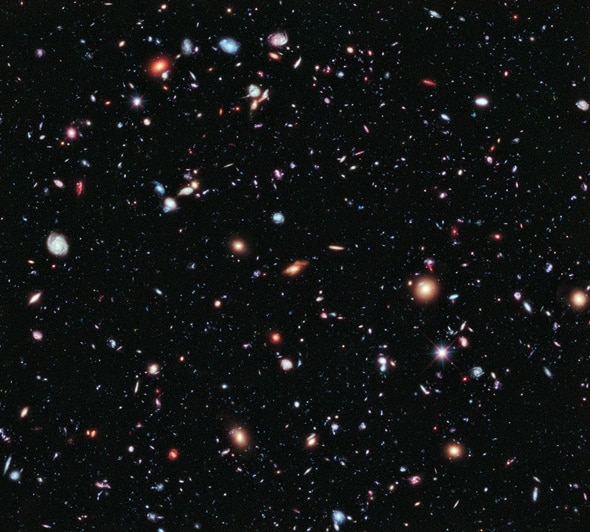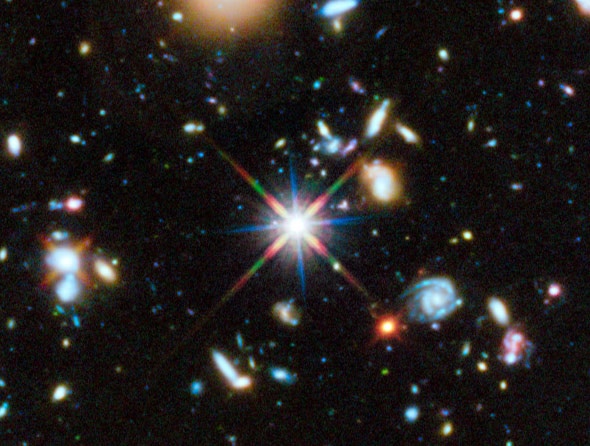Create a free profile to get unlimited access to exclusive videos, sweepstakes, and more!
The Sky Is Filled With Galaxies

A new paper just published in the prestigious Astrophysical Journal makes a stunning claim: There are 10 times as many galaxies in the Universe as we previously thought. At least. The total number comes in at about 2 trillion of them.
Two. Trillion. Galaxies.
Now, let me be clear. This doesn’t meant the Universe is 10 times bigger than we thought, or there are 10 times as many stars. I’ll explain—I mean, duh, it’s what I do—but to cut to the chase, what they found is that there are lots of teeny, faint galaxies very far away that have gone undetected. So instead of being in a smaller number of big galaxies, stars are divvied up into a bigger number of smaller ones.
What the astronomers did was look at extremely deep images of the Universe taken in surveys, for example the Hubble Ultra Deep Field. Hubble stared at a single point in the sky for nearly 1 million seconds—that’s more than 11 straight days—just seeing what it could see. The result is an image that is staggering in both its beauty and profundity. By counting the galaxies seen in the image, and then extrapolating to the whole sky, you can calculate that there are roughly 100 billion galaxies in the observable Universe.
That’s a lot of galaxies. But wait. It turns out that in this case, there really is more.
Surveys like the UDF are limited. Galaxies that are very faint are hard to see. We know there are small, faint galaxies in the Universe; there are lots of them close to us. Even then many of them are barely detectable because they have so few stars. Remove them to a distance of a few billion light-years and they’re faint. Even Hubble can’t see ‘em.
The astronomers who did this research had an interesting problem. If these galaxies are too faint to see, how do you count them?
The answer is two-fold. One is to look out as far as we can to see all the galaxies we can, and then add up all the galaxies we can see in a given volume of space. By carefully observing these galaxies, we can lump them into bins according to size. So, you find at a given distance there are so-and-so many galaxies with a mass of 10 billion times the mass of the Sun (the mass of the Sun is referred to as a “solar mass”, and it’s a handy unit) in a given volume. In that same volume there are more galaxies with a billion solar masses, and fewer with 10 billion.
Those numbers change with distance. When we look at galaxies really far away, we see them as they were when they were younger, because it takes a long time for their light to reach us. Galaxies really got started forming a few hundred million years after the Universe itself formed, but most were small. Over time they merged together to form bigger galaxies like ours (the Milky Way). So you need to carefully count up all the galaxies in a given volume of space at a certain distance from us, and then do that again for a region of space farther away, and so on.
At the same time, these faint galaxies are easier to see close to us, and harder farther away. So to get an idea of the number when we can’t actually see them, the researchers looked at individual galaxies nearby and figured out what kinds of stars they’re expected to have in them. Most have a few really bright, massive stars, and lots of smaller, fainter ones. The ratio tells you how bright a given galaxy is.
They calculated this for all kinds of galaxies, right down to really small ones with about a million times the mass of the Sun. Galaxies don’t get much smaller than this; objects with lower masses are more like clusters of stars in bigger galaxies, not galaxies themselves.
They can then combine these two pieces of information: How many faint galaxies there are near us and how bright they are, with how many galaxies of a given mass are in a volume of space. When they did that, they could extrapolate to figure out how many really faint galaxies there are at the most distant reaches of space, up to a distance of more than 13 billion light-years. When the light from those galaxies left on their journey to us, the Universe itself was only about 650 million years old!
And that’s how they found that there are at least 2 trillion galaxies in the Universe.
Mind you, just because we don’t see 90 percent of the galaxies in the Universe doesn’t mean this explains dark matter or anything like that. We know that’s not made of any kind of normal matter like the stuff that makes up stars, planets, you, and me. These unseen galaxies are extremely far away, and made of stars and gas and dust just like galaxies here are. It’s just that they’re faint.
And it doesn’t mean the Universe has 10 times more mass than we thought. The mass is the same, it’s just distributed differently than we thought. It’s like knowing there are 1 million people in a city, and finding out they live in 100,000 buildings when you thought they were only in 10,000. There are more buildings, but not more people.
As the authors themselves say:
The total number of galaxies in the universe is an interesting scientific question, although it may not reveal anything fundamental about the cosmology or underlying physics of the universe.
So yeah, this is cool, but not necessarily critical knowledge.
But it does say some pretty interesting things. It means that we should expect to find a helluva lot more galaxies when we take deeper surveys, perhaps with observatories like the James Webb Space Telescope, which should launch in 2018. And it lends a lot of support to the idea that small galaxies formed first in the Universe and grew large as they ate each other. We kinda knew this already, but it’s nice to see independent evidence of it.
And yes, even I have to admit that in the end it’s still just cool. Two trillion galaxies is a lot.
A whole lot. A Universe worth.
Oh, there is another thing, and this one is the coolest of them all. Because we now know how many galaxies there are, how they’re distributed throughout the Universe, and roughly how big they are physically, it’s possible to calculate how much of the sky is covered in galaxies. Think of it this way: If you’re in a very thinly populated copse of trees, you can look around and see things outside the copse; buildings and such in the distance. But if you’re deep within a forest of trees, everywhere you look you see trees.
So the researchers did this, and they found an astonishing thing: Given all the numbers they calculated, it looks very much that every single part of the sky is covered at least in part by a galaxy!
Do you see what this means? No matter where you look—up, down, left, right—and no matter how much you magnify the view through a telescope, at some point wherever you’re looking there’s a galaxy. It might be close by, or more likely crushingly far away, but it’s out there.
The sky is literally covered in galaxies.
How about that? It gives me a chill just to write that. Wow.
But when I read things like this—once the scientific wonder sinks in—I am always struck by a much deeper and far more wonderful notion: That we can know these things! We look up and we think about what we see, and we use math and science and engineering and we count the very essence of the Universe itself.
We are a part of the Universe, we are driven to understand it and ourselves, and that makes us mighty.



























